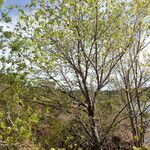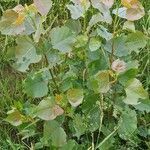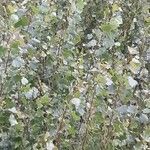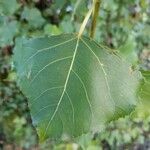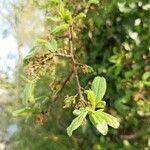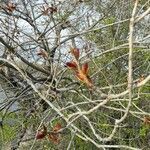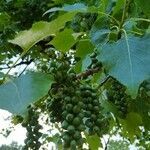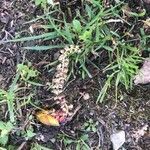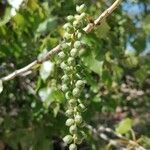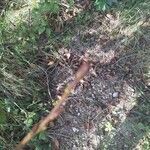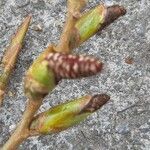Tall tree with dull gray branches and dark, furrowed bark on older trunks; petioles distinctly flattened; winter buds resinous; lvs pubescent when young, finely toothed, the teeth to ca 1 mm deep, more spreading than in no. 9 [Populus deltoides Marshall], only slightly or not at all incurved; lvs of short shoots rhomboid-ovate, with cuneate base, of long shoots broadly deltoid-ovate, truncate at base, abruptly pointed; floral disk 1–2 mm wide, stamens 20–30; stigmas 2, broadly dilated; frs ovoid, 7–9 mm, twice as long as the pedicels, with 4–8 seeds per placenta; 2n=38. Native of Eurasia, frequently planted, and occasionally escaped. The Lombardy poplar is a common horticultural form with erect branches, forming a long, columnar crown. (P. italica; P. nigra var. italica; P. dilatata)
Tree to 20 m high (more in cultivation), columnar or fastigiate. Bark rough, fissured. Branchlets light grey. Young shoots glabrous or puberulent. Buds and very young lvs viscid, glabrous. Young lvs not aromatic. Petiole 1.5-6 cm long, compressed, sometimes puberulent when young. Lamina 2.5-9 × 2-11 cm, rhombic-deltoid to rhombic, glabrous, green above and below; margin with narrow translucent border, crenate or crenate-serrate; base truncate to cuneate, glandless; apex usually cuspidate or acuminate. Catkins ♂, pendulous, to 7 cm long; scales at base to c. 2.3 cm long. Rachis glabrous, white. Bracts strongly laciniate, 2-2.5 mm long excluding the subulate teeth, glabrous, white. Cup-shaped disc 2-3 mm deep, oblique, glabrous. Stamens 15-30; anthers light to deep crimson.
Tree, 3-30 m high, terminal buds present; winter buds with several unequal outer scales; habitat narrowly columnar with erect branches. Leaves alternate; deltoid to broadly rhombic, dentate; petioles flattened. Inflorescences pendulous, odourless catkins, appearing before leaves. Flowers unisexual, anemophilous; borne in axil of a serrate or laciniate bract; perianth reduced to a cup-like disc. Male flowers with 4-30 or more stamens; filaments free; anthers 2-thecous, oblong to ovate, red. Female flowers none. Flowering time Sept.-Nov. Fruit none.
A large tree. It grows 30 m high and spreads 18 m wide. It has a round crown and a thick straight trunk. The bark is grey and knotted and gnarled. The leaves are triangle shaped. They are 4-7.5 cm long and wide. They have a long point at the tip. They are wavy and have teeth along the edge. They are green above and paler underneath. They turn yellow in autumn. The leaf stalks are slender and flattened and 2.5-5 cm long. The flowers are catkins 5 cm long. They are narrow and droop.
Columnar tree to 30 m; branches erect, fastigate; bark rough, grey, strongly furrowed, developing round ‘burrs’ (the remains of dense clusters of epicormic twigs) with age. Buds very sticky. Leaves broadly triangular to rhombic, 4–8 cm long, 4–10 cm wide, glabrous; margins closely but obtusely dentate, with narrow translucent marginal band, the teeth gland-tipped. Male catkins 5–7 cm long, lax; stamens 20–30; floral bracts laciniate, caducous.

